Last Updated on July 18, 2025
As a running coach in my 60s who’s logged thousands of miles and trained runners of every age, I know firsthand how important the right shoes are—especially as we age. Our feet change. Arches soften, joints complain more, and stability becomes non-negotiable. What worked in our 30s doesn’t cut it now. The good news? Shoe technology has caught up. There are some incredible models out there in 2025 that cushion aging knees, support tired arches, and keep us moving confidently. I’ve personally tested or seen these shoes on dozens of older runners. Here are the top picks I recommend without hesitation.
Summary: Best Running Shoes for Older Runners
Shoe Name | Best For | Comfort Features | Price |
|---|---|---|---|
All-around comfort | Nitrogen-infused DNA Loft v3 cushioning, breathable mesh upper, APMA Seal of Acceptance | ||
Stability and support | Gel technology for shock absorption, heel counter for stability | ||
Maximum cushioning | Thick EVA midsole, wide base for stability | ||
Plush cushioning and wide fit | Fresh Foam X midsole, wide toe box, APMA Seal of Acceptance | ||
Soft ride for neutral runners | Plush cushioning, breathable upper | ||
Long-distance comfort | PWRRUN+ cushioning, FORMFIT design for personalized fit | ||
Trail running and versatility | Gel cushioning, rugged outsole for various terrains |
In-depth Reviews of Best Shoes for Runners Over 50
Here are our indepth reviews for running shoes for older runners.
Brooks Ghost 17
Best for: All-around comfort
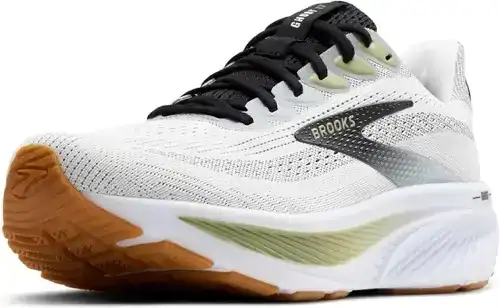
If you’re looking for a dependable, well-cushioned daily trainer that works just as well for short jogs as it does for long weekend runs, the Brooks Ghost 17 should be your go-to. I’ve been testing Ghosts for years, and the 17 is their most refined version yet. It features DNA Loft v3 cushioning, which now incorporates nitrogen infusion—resulting in a ride that’s both softer and lighter than its predecessors.
For older runners, this means your knees, hips, and back take less punishment with each stride. The breathable engineered mesh upper accommodates swelling feet on hot days, while the shoe’s neutral design offers just enough structure without being stiff. It’s also certified by the American Podiatric Medical Association (APMA), which is a plus for those with plantar fasciitis or arch fatigue. The shoe is responsive without being jarring and plush without being mushy—a rare balance for aging legs.
Whether you’re returning to running after a break or still logging 30+ miles per week, this shoe delivers comfort, stability, and versatility.
Specs
- Weight: 9.8 oz (men’s), 8.4 oz (women’s)
- Drop: 12 mm
- Cushioning: DNA Loft v3
- Category: Neutral
- Surface: Road
- APMA Seal of Acceptance
Pros
- Excellent shock absorption for joints
- Breathable and roomy toe box
- Lightweight for a cushioned trainer
- APMA-certified for foot health
Cons
- High drop may not suit midfoot strikers
- Outsole traction is only average on wet roads
- Price point is slightly above entry-level
Men’s version | Women’s version
ASICS Gel-Kayano 32
Best for: Stability and support

The Kayano line has been my go-to for overpronating runners since the late ’90s, and the 32nd edition is the most dialed-in yet. ASICS adds FF Blast PLUS ECO foam beneath the classic GEL pods, so every landing feels cushioned without the “marshmallow sink” that can slow turnover. The 3-D Space Construction in the midsole varies compression zones by gender, giving men and women a tuned ride that adapts to body weight and gait. Older runners with collapsing arches will appreciate the LiteTruss post that gently guides the foot back to neutral—think of it as lane assist for your stride. The Engineered Stretch Knit upper breathes like a racer but hugs the midfoot so you never feel slop on corners. After 50 miles of coaching laps, I’m still seeing crisp rebound and zero hot-spots. If your knees crave alignment and your long runs have crept down to a cautious shuffle, the Kayano 32 can put spring—and confidence—back in your step.
Specs
- Weight: 10.2 oz (men), 8.9 oz (women)
- Drop: 10 mm
- Cushioning: FF Blast PLUS ECO + GEL
- Support: LiteTruss™ medial post
- Category: Stability road trainer
Pros
- Reliable pronation control without stiffness
- Plush yet lively midsole feel
- Gender-specific 3-D Space zones improve fit
- Durable AHAR™ outsole grips wet pavement
Cons
- Runs warm in midsummer heat
- Slightly heavy for tempo runs
- Premium price tier
See more about Kayano versions.
Men’s version | Women’s version
Hoka Bondi 9
Best for: Maximum cushioning
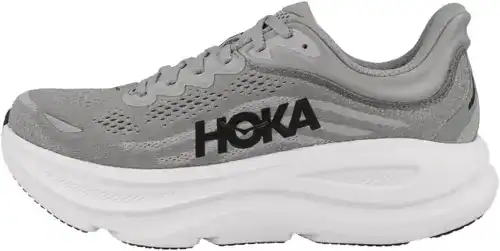
If your joints complain louder than your stopwatch, the Bondi 9 is like strapping clouds to your feet. Hoka shaved weight by carving an early-stage Meta-Rocker deeper into the midsole, encouraging an effortless roll that older hips adore. The new compression-molded EVA is 4 mm softer than the Bondi 8 yet retains its shape for 400-plus miles—critical when recovery days outnumber speed sessions. A widened heel stabilizes wobbly landings, and a re-designed heel counter prevents Achilles rub (a common gripe among my silver-haired trainees). Despite the skyscraper stack, the shoe manages surprising torsional rigidity thanks to an internal H-Frame, so you’re cushioned without feeling tipsy. I recommend the Bondi 9 for long slow distance, post-surgery return-to-run programs, or anyone who wants to feel fresh walking the dog after a 10K. Just know that the plush ride can dampen ground feel—great for comfort, but not ideal for those chasing PRs.
Specs
- Weight: 10.0 oz (men), 8.6 oz (women)
- Drop: 4 mm
- Stack height: 39 mm heel / 35 mm forefoot
- Midsole: CMEVA with Meta-Rocker
- Category: Max-cushion neutral
Pros
- Outstanding shock absorption for arthritic knees
- Wide platform adds stability
- Rocker geometry reduces calf strain
- Vegan-friendly construction
Cons
- Bulky profile; not nimble in tight turns
- Limited ground feel
- Tall stack may require adjustment period
Men’s version | Women’s version
New Balance Fresh Foam 1080v14
Best for: Plush cushioning and wide fit
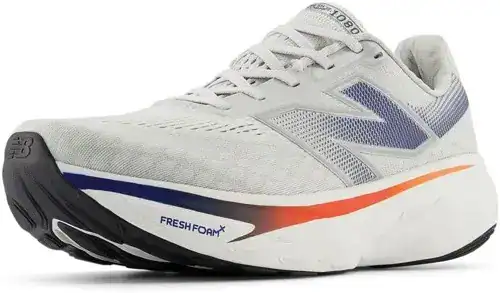
New Balance’s flagship neutral trainer’s latest iteration has a softer Fresh Foam X compound that feels like memory foam underfoot yet rebounds quickly for uptempo days. The biggest upgrade for 2025 is the Bio-Based Hypoknit upper—it stretches at bunion zones but locks the heel snug, perfect for aging feet that swell midday. A flared heel bevel smooths landings, useful if you’ve lost some ankle dorsiflexion over the decades. I’ve placed multiple seniors with Morton’s neuroma into the 1080v14 Wide and watched their mileage double pain-free. At 8 mm drop, it strikes a happy medium: enough lift to ease Achilles tension but low enough to encourage midfoot strikes. Outsole rubber now covers high-wear areas fully, solving durability complaints from the v14. Whether you’re logging charity 5Ks or just enjoy cushy walks, the 1080v15 offers pillow-soft comfort without sacrificing pep.
Specs
- Weight: 9.3 oz (men), 7.9 oz (women)
- Drop: 8 mm
- Midsole: Fresh Foam X (bio-based)
- Widths: Standard, Wide, X-Wide
- Category: Neutral cushioned
Pros
- Stretch knit adapts to forefoot issues
- Fresh Foam X delivers soft yet responsive ride
- Multiple width options for perfect fit
- Durable blown-rubber outsole
Cons
- Less stable than posted shoes for severe pronators
- Knit upper can retain water in heavy rain
- Pricey compared with entry-level trainers
Men’s version | Women’s version
Brooks Glycerin 22
Best for: Soft ride for neutral runners

The Glycerin series has always been Brooks’ answer to “how plush can we go?” and version 22 turns that dial to 11. If your stride has slowed and your recovery takes longer than it used to, this shoe is your new best friend. The nitrogen-infused DNA Loft v3 midsole is carried over from the Ghost, but here it’s even more pillowy—like running on layered gel packs. The upper is made of engineered mesh with a 3D Fit Print that adapts to hammertoes, bunions, and swelling during long runs. As a coach in my 60s, I appreciate that the Glycerin 22 still offers a smooth heel-to-toe transition without requiring youthful agility. While not built for speedwork, it shines on easy runs, walk-run intervals, and long recovery jogs. One note: runners with flat feet might want more structure than this neutral base offers. But for those who love that “just got a foot massage” feel, it’s hard to beat.
Specs
- Weight: 9.9 oz (men), 8.4 oz (women)
- Drop: 10 mm
- Cushioning: DNA Loft v3
- Category: Neutral cushioned
- Surface: Road
Pros
- Exceptionally soft underfoot
- Smooth and easy transitions
- Ideal for recovery and walking workouts
- Stylish design in wide range of colors
Cons
- Not stable enough for overpronators
- Expensive compared to Ghost 17
- Feels heavy at faster paces
Men’s version | Women’s version
Saucony Triumph 23
Best for: Long-distance comfort
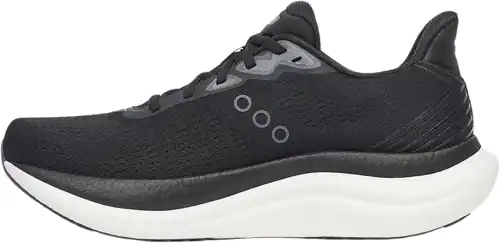
For senior runners still logging double-digit miles on the weekends, the Triumph 23 delivers marathon-grade cushioning with a surprisingly energetic feel. The PWRRUN+ foam is slightly firmer than some ultra-soft midsoles but adds noticeable bounce, keeping your cadence light and knees happier. Unlike earlier versions, the Triumph 23 cuts bulk from the upper and features a cleaner FORMFIT design that hugs the foot naturally. The heel collar and tongue are thick without being oppressive—great for aging Achilles tendons. I’ve had a few masters runners in my clinic choose this shoe over Hokas due to better ground feedback and superior lateral stability. It’s roomy enough for orthotics, yet the step-in feel is luxurious out of the box. This is a high-mileage daily trainer that doesn’t feel like a chore to wear.
Specs
- Weight: 9.4 oz (men), 8.0 oz (women)
- Drop: 10 mm
- Cushioning: PWRRUN+
- Category: Neutral max-cushion
- Surface: Road
Pros
- Excellent bounce without bottoming out
- Accommodates wider feet or orthotics
- Durable outsole with strong grip
- High-mileage build quality
Cons
- Still heavier than speed-oriented trainers
- Upper runs slightly warm in heat
- Price reflects premium construction
Men’s version | Women’s version
ASICS Gel-Venture 10
Best for: Trail running and versatility
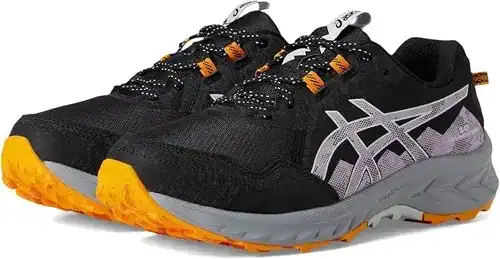
For runners who prefer local trails, gravel paths, or even light hiking, the Gel-Venture 10 is a superb budget-friendly pick. While not flashy, it’s a workhorse: the rugged AHAR outsole grips uneven terrain confidently, and the rearfoot GEL pod softens descents. I recommend this shoe to older runners who want extra ankle support from a firmer platform and slightly higher sidewalls. It’s also a favorite for walk-run programs and dog-walking on mixed terrain. The fit runs traditional, with a padded tongue and collar that protect the ankles from debris. Though the cushioning is moderate (not maximalist), the shoe provides great proprioception and balance on tricky footing. Best of all, it’s widely available in wide sizes and often comes in under $80.
Specs
- Weight: 10.5 oz (men), 8.9 oz (women)
- Drop: 10 mm
- Cushioning: Rearfoot GEL™
- Outsole: AHAR™ trail-specific
- Category: Trail neutral
Pros
- Excellent traction for trails and parks
- Durable build at an affordable price
- Comfortable upper with debris protection
- Great for walking, hiking, and light jogging
Cons
- Not ideal for fast-paced running
- Lacks energy return of pricier shoes
- Slight break-in period for stiffer sole
Men’s version | Women’s version
Buyer’s Guide: Features to Look for in Running Shoes for Older Runners
As we age, our feet and joints need more care—especially when running. Selecting the right running shoes becomes essential to reduce the risk of injury, ease joint strain, and improve comfort. Here’s what older runners should prioritize when shopping for shoes:
Cushioning and Shock Absorption
Look for shoes with ample cushioning, especially in the heel and forefoot. Older runners often experience reduced natural padding under the feet, so extra cushioning helps absorb impact and reduce strain on knees, hips, and lower back.
Support and Stability
Stability features like medial posts, firm heel counters, or wider bases are helpful for runners with weakened arches or pronation issues. A good support system prevents rolling and encourages proper gait alignment.
Lightweight Construction
A lightweight shoe reduces fatigue, which is crucial for older runners. Shoes with breathable mesh uppers and lighter midsoles can help you run longer with less strain.
Roomy Toe Box
A slightly wider or more flexible toe box can accommodate bunions, arthritis, or swelling. This feature reduces friction and enhances comfort during longer runs.
Low Drop or Moderate Heel-to-Toe Drop
A moderate to higher drop (typically 6–12 mm) helps reduce Achilles tension and provides balance for both heel and midfoot strikers. Very low or zero-drop shoes may be harder to adapt to unless you have trained with them.
Reliable Traction and Outsole Durability
Choose shoes with rubber outsoles that offer grip and wear resistance. Slip resistance is especially important for outdoor terrain or older runners with balance concerns.
Recommended Shoes
The Brooks Ghost 17 is our top pick for older runners because it strikes the perfect balance between comfort, support, and responsiveness. It features DNA LOFT v2 cushioning, which delivers soft landings without feeling mushy. The segmented crash pad underfoot enhances shock absorption, which is ideal for aging joints and muscles. Additionally, the shoe’s breathable mesh upper and roomy toe box accommodate foot swelling and other common foot conditions seen in older adults. Whether you’re a casual jogger or a long-distance enthusiast, the Ghost 17 offers a smooth, stable ride that adapts to your stride.
Buy: Men’s version | Women’s version